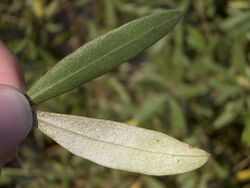Biology:Olive leaf

Olive leaf is the leaf of the olive tree (Olea europaea). Although olive oil is well known for its flavor and possible health benefits, the leaf and its extracts remain under preliminary research with unknown effects on human health.
Leaf characteristics
The silvery green leaves are oblong, measuring 4–10 centimetres (1.6–3.9 inches) long and 1–3 centimetres (0.39–1.18 inches) wide. When consumed, leaves have an astringent bitter taste.[citation needed]
Chemical compounds
Olive phenolics are much more concentrated in the leaves compared with olive fruit or olive oil: 1450 mg total phenolics/100 g fresh leaf vs. 110 mg/100 g fruit and 23 mg/100 ml extra virgin olive oil.[1][2] Chemical compounds in unprocessed olive leaf are oleuropein and hydroxytyrosol, as well as polyphenols and flavonoids, including luteolin, rutin, caffeic acid, catechin and apigenin.[3] Elenolic acid is a component of olive oil and olive leaf extract. It can be considered as a marker for maturation of olives.[4] Oleuropein, together with other closely related compounds such as 10-hydroxyoleuropein, ligstroside and 10-hydroxyligstroside, are tyrosol esters of elenolic acid.[2] The phenolic composition of olive leaf extract varies according to plant variety, harvesting season and method, leaf maturity, storage conditions and extraction method.[citation needed]
Culinary uses
Olive leaves are sometimes used in deluxe Chinese cuisine. Olive leaves have been used by Gina Keatley in the creation of Matche, powdered olive leaves used on desserts and in tea.[5]
Historical uses
Historically the benefits of olive leaves have been used in traditional medicine practices[2] as folk remedies for the treatment of various illnesses.[6] Studies suggest that olive leaf extract could help balance blood sugar in type 2 diabetes patients.[7] However, scientific evidence for health effects of using olive leaf extract has been deemed insufficient by the European Food Safety Authority to prove any cause-and-effect relationship.[8]
References
- ↑ "Impact of phenolic-rich olive leaf extract on blood pressure, plasma lipids and inflammatory markers: a randomised controlled trial". European Journal of Nutrition 56 (4): 1421–1432. 2017. doi:10.1007/s00394-016-1188-y. PMID 26951205.
- ↑ 2.0 2.1 2.2 Barbaro, B; Toietta, G; Maggio, R; Arciello, M; Tarocchi, M; Galli, A; Balsano, C (2014). "Effects of the Olive-Derived Polyphenol Oleuropein on Human Health". International Journal of Molecular Sciences 15 (10): 18508–18524. doi:10.3390/ijms151018508. PMID 25318054.
- ↑ Herrero, M; Temirzoda, T. N.; Segura-Carretero, A; Quirantes, R; Plaza, M; Ibañez, E (2011). "New possibilities for the valorization of olive oil by-products". Journal of Chromatography A 1218 (42): 7511–20. doi:10.1016/j.chroma.2011.04.053. PMID 21600577.
- ↑ Esti, M; Cinquanta, L; La Notte, E (1998). "Phenolic Compounds in Different Olive Varieties". Journal of Agricultural and Food Chemistry 46 (1): 32–35. doi:10.1021/jf970391+. PMID 10554192. "Elenolic acid glucoside and hydroxytyrosol can be considered indicators of maturation for olives".
- ↑ "Sicilian Olive Leaf Tea Company Releases Matche at 'World Tea'". 22 March 2022. https://www.worldteanews.com/products-equipment/sicilian-olive-leaf-tea-company-releases-matche-world-tea.
- ↑ "Quali-quantitative analysis and antioxidant activity of different polyphenolic extracts from Olea europea L. leaves". Journal of Commodity Science 39 (2): 71–83. 2000.
- ↑ "Olive leaf extract could help treat type 2 diabetes: Study" (in en). 2020-01-27. https://indianexpress.com/article/lifestyle/health/olive-leaf-extract-type-2-diabetes-study-6237612/.
- ↑ "Scientific Opinion on the substantiation of a health claim related to olive (Olea europaea L.) leaf water extract and increase in glucose tolerance pursuant to Article 13(5) of Regulation (EC) No 1924/2006". EFSA Journal 12 (5). 2014. doi:10.2903/j.efsa.2014.3655.
 |
